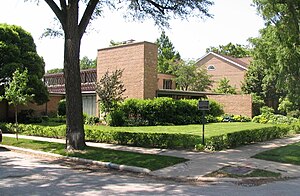Bertrand Goldberg




Bertrand Goldberg (July 17, 1913 – October 8, 1997) was an American architect best known for the Marina City complex in Chicago, Illinois, the tallest residential concrete building in the world at the time of completion.
Life and career
Goldberg was born in Chicago, and trained at the Cambridge School of Landscape Architecture (now part of Harvard University). At age eighteen, in 1932, he went to Germany to study at the Bauhaus, working in the small office of architect Ludwig Mies van der Rohe. Following civil unrest in Berlin, Goldberg fled to Paris in 1933 and soon returned to Chicago, where he first worked for modernist architects Keck and Keck, Paul Schweikher, and Howard Fisher. Goldberg opened his own architectural office in Chicago in 1937.
Goldberg was known for innovative structural solutions to complex problems, particularly for residential, institutional, and industrial design projects. One of Goldberg's first commissions, in 1938, was for the North Pole chain of ice cream shops. His ingenious design allowed the small shops to be disassembled, transported, and reassembled with little effort. Its flat roof was supported by tension wires from a single, illuminated column rising up through the shop's center; glass windows and a door formed a box below the roof.
Goldberg's experimental plywood boxcars, demountable housing units for military use during and after World War II, led him to seek unconventional forms through mundane materials such as plywood and concrete. Perhaps his best-known commission, Marina City in Chicago (1961–1964), incorporated many different functions into a mixed use complex of five buildings. The two sixty-story towers are on the river's edge, and are well known Chicago features, with striking multi-lobed columnar forms often described as "corn cobs". In addition to the towers, comprising apartments and parking, there was a complex pattern of activities that were incorporated into the original design, including an office building, theater, public pedestrian plaza, an active rail line, a marina, an ice skating rink, and a bowling alley. Much of the complex has evolved and changed over time, and the pattern of activities has shifted significantly, but with only minor changes to Goldberg's design. The office building is now a hotel, and the theater is now the Chicago House of Blues. The rail line has since been abandoned, and the skating rink has been covered by a later addition housing a steakhouse.
After the success of Marina City, Goldberg received many more large commissions for hospitals, schools, and other public institutional buildings, such as Prentice Women's Hospital for Northwestern University, science and medical complexes for SUNY Stony Brook, Good Samaritan Hospital in Phoenix, Arizona, as well as River City and the Hilliard Homes public housing complex in Chicago.
During his career, Goldberg designed a rear-engine automobile, canvas houses, unique furniture, prefabricated houses, and mobile vaccine laboratories for the United States government. He collaborated on some projects with his friend and fellow 'design scientist' R. Buckminster Fuller, as well as other modernists.
In the late 1930s, Goldberg was present at the famous meeting of Frank Lloyd Wright and Ludwig Mies van der Rohe at Taliesin. He also was friends with Josef Albers, who taught him at the Bauhaus. After the success of Marina City, Goldberg moved his work to focus on larger scale social, planning, and engineering issues, and proposed many progressive urban projects, at a time when the future of urban growth and development in the United States was not always clear. Goldberg also wrote extensively on urban issues and other historical and cultural issues.
The Bertrand Goldberg Archive is held by the Ryerson & Burnham Libraries at the Art Institute of Chicago. The archive includes photographs, drawings, correspondence, and audiovisual materials.
References
- Bibliography
- Jay Pridmore, George A. Larson, Chicago Architecture and Design : Revised and expanded, Harry N. Abrams, Inc., New York, 2005. ISBN 0-8109-5892-9.
- Notes
This article needs additional citations for verification. (August 2011) |
External links
- Forgotten Chicago series on Bertrand Goldberg
- Oral history interview with Bertrand Goldberg
- Website on Bertrand Goldberg
- Bertrand Goldberg Archive
